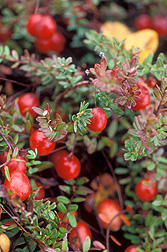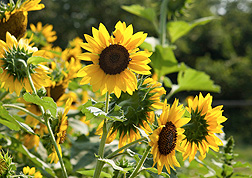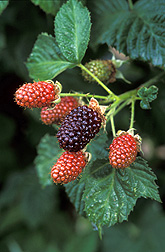National Inventory Takes Stock of Crops’ Wild Relatives
An estimated one of every five plant species worldwide is endangered by habitat loss, climate change, invasive species, and other threats. In the United States alone, roughly 30 percent of native plant species are similarly threatened, and a surprising number may be closely related to crop plants we use every day. Losing these and other crop wild relatives (CWR) could be detrimental to agriculture both domestically and abroad, researchers say. That’s because these wild relatives provide critical sources of genetic diversity that can be tapped for an array of economically important traits—such as resistance to emerging pests and diseases, increased yield, and better drought tolerance or adaptability.
Over the past few years, Agricultural Research Service and collaborating scientists have worked to create a first-of-its-kind inventory for U.S. wild and weedy crop relatives that prioritizes the species by their importance to breeding new, improved varieties. In doing this, the researchers looked at how closely related the wild species are to crops—especially those grown for food—which determines the ease or difficulty in transferring desirable traits to their cultivated cousins. Another consideration was their availability in gene banks or protected habitat areas, explains ARS plant geneticist Stephanie Greene.
Greene has been collaborating on the inventory project with John Wiersema, a botanist with the ARS National Germplasm Resources Laboratory in Beltsville, Maryland, and scientists from the International Center for Tropical Agriculture (CIAT) in Colombia, Wageningen University (WU) in The Netherlands, and the University of Birmingham (UB) in the United Kingdom. Additional support was provided by the Global Crop Diversity Trust, which spearheads a worldwide project to collect CWR that haven’t been conserved in gene banks and to breed useful CWR traits into crops.
Such efforts “also provide a good opportunity for international collaboration, as no single country is self-sufficient in CWR diversity,” comments Nigel Maxted, a senior UB lecturer on plant genetics conservation. “Each country grows a mix of crops that originate outside its borders, so cross-border collaboration is key if all breeders are to retain access to the CWR diversity they need to sustain food security in the face of climate change.”
All told, the U.S. national inventory covers 4,596 taxa from 985 genera and 194 plant families that are either indigenous to the United States or have become “naturalized”—established of their own accord following human introduction. Among CWR of major crops, the genus Helianthus (sunflower) is the most abundant, numbering 73 total species, including H. annuus (domesticated as the sunflower). Other important CWRs include species closely related to strawberry; stone fruits such as cherries and plums; blackberries; raspberries; blueberries; and grapes. The inventory also contains entries for traditional or iconic crops unique to the United States, such as pecan, American chestnut, and wild rice, as well as so-called “wild-utilized species,” with direct use for medicinal, ornamental, landscaping, environmental restoration, or industrial purposes.
“We have identified approximately 250 species of CWR that are considered high priority because they have a lot of potential in plant breeding,” says Greene, who works in ARS’s Plant Germplasm Introduction and Testing Research Unit worksite in Prosser, Washington. “We also identified species that are vulnerable because they are rare, endangered, or have not been collected and placed in gene banks.” Crop wild relatives with limited representation in U.S. gene banks include species related to cotton (Gossypium), lettuce (Lactuca), plums (Prunus), gooseberry (Ribes), sugarcane (Saccharum), cranberry (Vaccinium), and wild rice (Zizania), she adds.
National CWR inventories have already been assembled in Europe and other parts of the world. Despite its 20,000 species of native or naturalized plants, North America (excluding Mexico) has not been considered a major center of crop genetic diversity, as Central and South America, the Middle East, and other regions have been. This is because few major crop progenitors other than sunflower are native to North America, note Greene, Wiersema, Maxted, and coauthors Colin Khoury (CIAT, WU), Andy Jarvis (CIAT), and Paul Struik (WU) in the July 2013 issue of Crop Science.
Nonetheless, there are many examples of native wild species that have played key roles in ensuring the continued health and productivity of crops grown worldwide. The inventory itself lists 17 major crops that have benefitted from traits associated with 55 native CWR. For example, in the late 1800s, North American wild grape rootstocks provided a key source of Phylloxera resistance necessary to develop hardier European grape varieties. Today, these rootstocks remain foundation sources of protection against the sap-sucking insect. More recently, cultivated sunflowers worldwide have benefitted from their wild North American relatives in the form of resistance to rust, Sclerotinia, downy mildew, and other diseases and pests.
In addition to the value to plant breeding, other considerations in prioritizing the U.S. national inventory included the CWR’s conservation status, an effort aided by accessing sources such as NatureServe, a nonprofit information clearinghouse for rare or endangered species and threatened ecosystems. The team also compiled a list of major world crops, using sources such as the United Nation’s Food and Agriculture Organization, and queried the ARS Germplasm Resources Information Network (GRIN) maintained in Beltsville, Maryland, to determine which CWRs occurring in the United States were genetically related to the crops.
Future plans are to fully integrate the inventory’s information into GRIN to take advantage of the existing data there and facilitate searches by taxonomy, threat status, and geographic distribution. Wiersema will play a lead role on that effort.
Meanwhile, Khoury, in pursuit of his Ph.D., is performing a “gap analysis.” This involves examining the distribution of CWRs and identifying areas where species are already protected, such as in national parks, or in need of protection. Of particular interest are regions where CWR species overlap and the benefits of establishing a reserve to safeguard them could be especially high. Khoury’s analysis also looks at gaps that could be filled in the germplasm collections of U.S. gene banks, including the National Plant Germplasm System. The results, coupled with the inventory, “will be used by ARS to direct future domestic collecting efforts and to help develop a national CWR conservation strategy that involves land management agencies, such as the U.S. Forest Service,” says Greene.—By Jan Suszkiw, Agricultural Research Service Information Staff.
This research is part of Plant Genetic Resources, Genomics, and Genetic Improvement, an ARS national program (#301) described at www.nps.ars.usda.gov.
Stephanie Greene is in the USDA-ARS Plant Germplasm Introduction and Testing Research Unit, 24106 North Bunn Rd., Prosser, WA 99350; (509) 786-9265.
"National Inventory Takes Stock of Crops’ Wild Relatives" was published in the January 2014 issue of Agricultural Research magazine.









